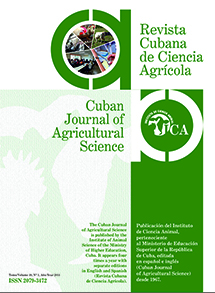Partial substitution of commercial concentrate for Azolla filiculoides meal in the productive response of Oryctolagus cuniculus
Contenido principal del artículo
Resumen
In order to evaluate the effect of partial substitution of commercial concentrate (CC) for Azolla filiculoides (HA) meal in rabbit productive indicators (Oryctolagus cuniculus), a completely randomized design was used with 48 animals of 35 days old and mean weight of 646.3 ± 9.5 g. This study was carried out in Río Cauto municipality, Granma province, Cuba. Four treatments were used, consisting of 0, 6, 12 and 18% substitution of balanced feed for Azolla meal. Each treatment consisted of three replications and these with four experimental units in a simple classification design. Azolla meal showed 20.74 and 19.34 % of crude protein and fiber, respectively, as well as an adequate amino acid composition, highlighting methionine and leusin values of 14 and 38 g/kg
CP, respectively. DM, CP and EM intake was superior for the commercial concentrate with 6,849 g, 1,205 g and 849.98 MJ/kg of DM, respectively. For the increase of liveweight, the best values belonged to the control treatment and to 12% of HA inclusion, with 2,276.11 and 2,258.78g, respectively. Something similar occurred for total mean gain with 27.32 g for CC and 27.05 g for the 12% inclusion treatment. Azolla meal has a suitable chemical composition to be used in the feeding of rabbits. The inclusion of up to 12% of this meal in the ration for rabbits did not affect the productive indicators evaluated.
Key words: feeding, composition, conversion, gain, weight
CP, respectively. DM, CP and EM intake was superior for the commercial concentrate with 6,849 g, 1,205 g and 849.98 MJ/kg of DM, respectively. For the increase of liveweight, the best values belonged to the control treatment and to 12% of HA inclusion, with 2,276.11 and 2,258.78g, respectively. Something similar occurred for total mean gain with 27.32 g for CC and 27.05 g for the 12% inclusion treatment. Azolla meal has a suitable chemical composition to be used in the feeding of rabbits. The inclusion of up to 12% of this meal in the ration for rabbits did not affect the productive indicators evaluated.
Key words: feeding, composition, conversion, gain, weight
Detalles del artículo
Cómo citar
Méndez-Martínez, Y., Ramírez, J. L., Álvarez, A. R., Leyva, L., & Pérez, Y. (2019). Partial substitution of commercial concentrate for Azolla filiculoides meal in the productive response of Oryctolagus cuniculus. Cuban Journal of Agricultural Science, 53(2). Recuperado a partir de https://mail.cjascience.com/index.php/CJAS/article/view/876
Sección
Ciencia Animal
Aquellos autores/as que tengan publicaciones con esta revista, aceptan los términos siguientes:
- Los autores/as conservarán sus derechos de autor y garantizarán a la revista el derecho de primera publicación de su obra, el cuál estará simultáneamente sujeto a la Licencia Creative Commons Attribution-NonCommercial 4.0 International (CC BY-NC 4.0) que permite a terceros compartir la obra siempre que se indique su autor y su primera publicación esta revista. Bajo esta licencia el autor será libre de:
- Compartir — copiar y redistribuir el material en cualquier medio o formato
- Adaptar — remezclar, transformar y crear a partir del material
- El licenciador no puede revocar estas libertades mientras cumpla con los términos de la licencia
Bajo las siguientes condiciones:
- Reconocimiento — Debe reconocer adecuadamente la autoría, proporcionar un enlace a la licencia e indicar si se han realizado cambios. Puede hacerlo de cualquier manera razonable, pero no de una manera que sugiera que tiene el apoyo del licenciador o lo recibe por el uso que hace.
- NoComercial — No puede utilizar el material para una finalidad comercial.
- No hay restricciones adicionales — No puede aplicar términos legales o medidas tecnológicas que legalmente restrinjan realizar aquello que la licencia permite.
- Los autores/as podrán adoptar otros acuerdos de licencia no exclusiva de distribución de la versión de la obra publicada (p. ej.: depositarla en un archivo telemático institucional o publicarla en un volumen monográfico) siempre que se indique la publicación inicial en esta revista.
- Se permite y recomienda a los autores/as difundir su obra a través de Internet (p. ej.: en archivos telemáticos institucionales o en su página web) antes y durante el proceso de envío, lo cual puede producir intercambios interesantes y aumentar las citas de la obra publicada. (Véase El efecto del acceso abierto).
